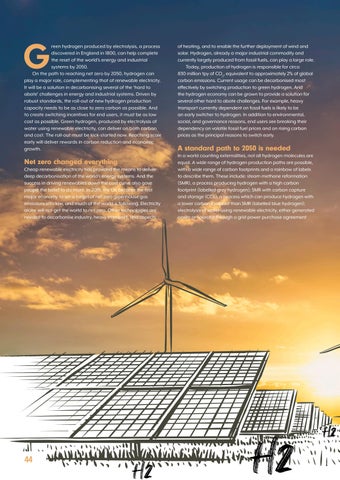G
reen hydrogen produced by electrolysis, a process discovered in England in 1800, can help complete the reset of the world’s energy and industrial systems by 2050. On the path to reaching net zero by 2050, hydrogen can play a major role, complementing that of renewable electricity. It will be a solution in decarbonising several of the ‘hard to abate’ challenges in energy and industrial systems. Driven by robust standards, the roll-out of new hydrogen production capacity needs to be as close to zero carbon as possible. And to create switching incentives for end users, it must be as low cost as possible. Green hydrogen, produced by electrolysis of water using renewable electricity, can deliver on both carbon and cost. The roll-out must be kick-started now. Reaching scale early will deliver rewards in carbon reduction and economic growth.
Net zero changed everything Cheap renewable electricity has provided the means to deliver deep decarbonisation of the world’s energy systems. And the success in driving renewables down the cost curve also gave people the belief to do more. In 2019, the UK became the first major economy to set a target of net zero greenhouse gas emissions into law, and much of the world is following. Electricity alone will not get the world to net zero. Other technologies are needed to decarbonise industry, heavy transport, and aspects
44
of heating, and to enable the further deployment of wind and solar. Hydrogen, already a major industrial commodity and currently largely produced from fossil fuels, can play a large role. Today, production of hydrogen is responsible for circa 830 million tpy of CO2, equivalent to approximately 2% of global carbon emissions. Current usage can be decarbonised most effectively by switching production to green hydrogen. And the hydrogen economy can be grown to provide a solution for several other hard to abate challenges. For example, heavy transport currently dependent on fossil fuels is likely to be an early switcher to hydrogen. In addition to environmental, social, and governance reasons, end users see breaking their dependency on volatile fossil fuel prices and on rising carbon prices as the principal reasons to switch early.
A standard path to 2050 is needed In a world counting externalities, not all hydrogen molecules are equal. A wide range of hydrogen production paths are possible, with a wide range of carbon footprints and a rainbow of labels to describe them. These include: steam methane reformation (SMR), a process producing hydrogen with a high carbon footprint (labelled grey hydrogen); SMR with carbon capture and storage (CCS), a process which can produce hydrogen with a lower carbon footprint than SMR (labelled blue hydrogen); electrolysis of water using renewable electricity, either generated onsite or sourced through a grid power purchase agreement
